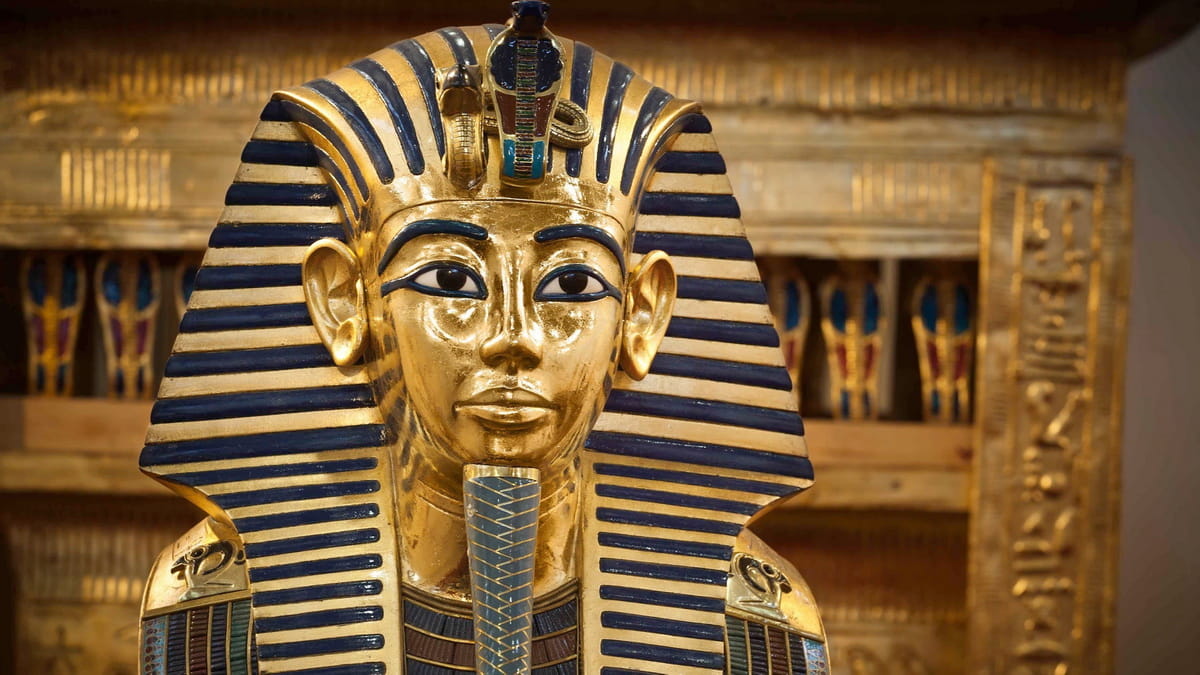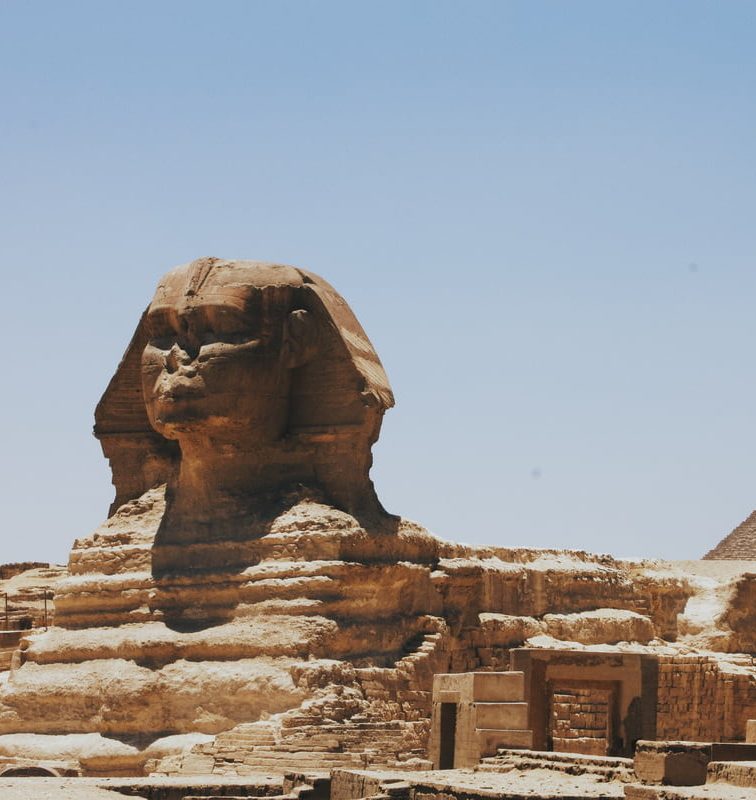King Tutankhamun, the boy-king of Egypt, ascended to the throne around 1332 BC at the age of nine or ten. His reign, during the tumultuous 18th Dynasty, was brief yet impactful, leaving a legacy that has fascinated historians and the public alike.
The discovery of his nearly intact tomb in 1922 by Howard Carter revealed a treasure trove of artifacts, providing unparalleled insights into Egypt’s past. Despite his short life, the wealth of his tomb, his mysterious death, and the allure of the curse have made King Tut an icon of ancient history.
1. Youngest Pharaoh’s Swift Ascendancy
Ascending to power as Egypt’s youngest pharaoh, Tutankhamun’s reign was marked by significant religious reform. Taking the throne around 1332 BC, his rule followed the chaotic Amarna period, characterized by his father Akhenaten’s radical monotheistic overhaul. Tutankhamun’s leadership was a return to traditional polytheistic worship, seen as an attempt to stabilize a divided kingdom.
Under his rule, Egypt saw a restoration of the old gods, including Amun, and a renunciation of Atenism. This shift not only reestablished religious order but also reasserted the pharaoh’s divine status, essential for maintaining the political and social hierarchy of ancient Egypt.
2. Restoration of Ma’at and Religious Reforms
Under the influence of his advisors and the priests of Amun, Tutankhamun (formerly Tutankhaten) initiated significant religious reforms to restore the traditional polytheistic worship and the god Amun’s preeminence. The Restoration Stele from his reign describes Egypt in chaos at the time of his accession, with temples abandoned and the gods’ cults abolished.
His efforts to repair the temples and restore the old religious practices were vital in reinstating the concept of Ma’at, the universal harmony crucial to ancient Egyptian belief.
3. Interim Pharaohs and Royal Upheaval
The period between the death of Akhenaten and Tutankhaten’s ascension was marked by brief reigns of interim pharaohs, including Smenkhkare and possibly Nefertiti under the alias of Smenkhkare, who might have ruled due to Akhenaten’s declining health and the young prince’s tender age.
This period was characterized by political instability and changes in religious leadership, setting the stage for Tutankhaten’s future reforms.
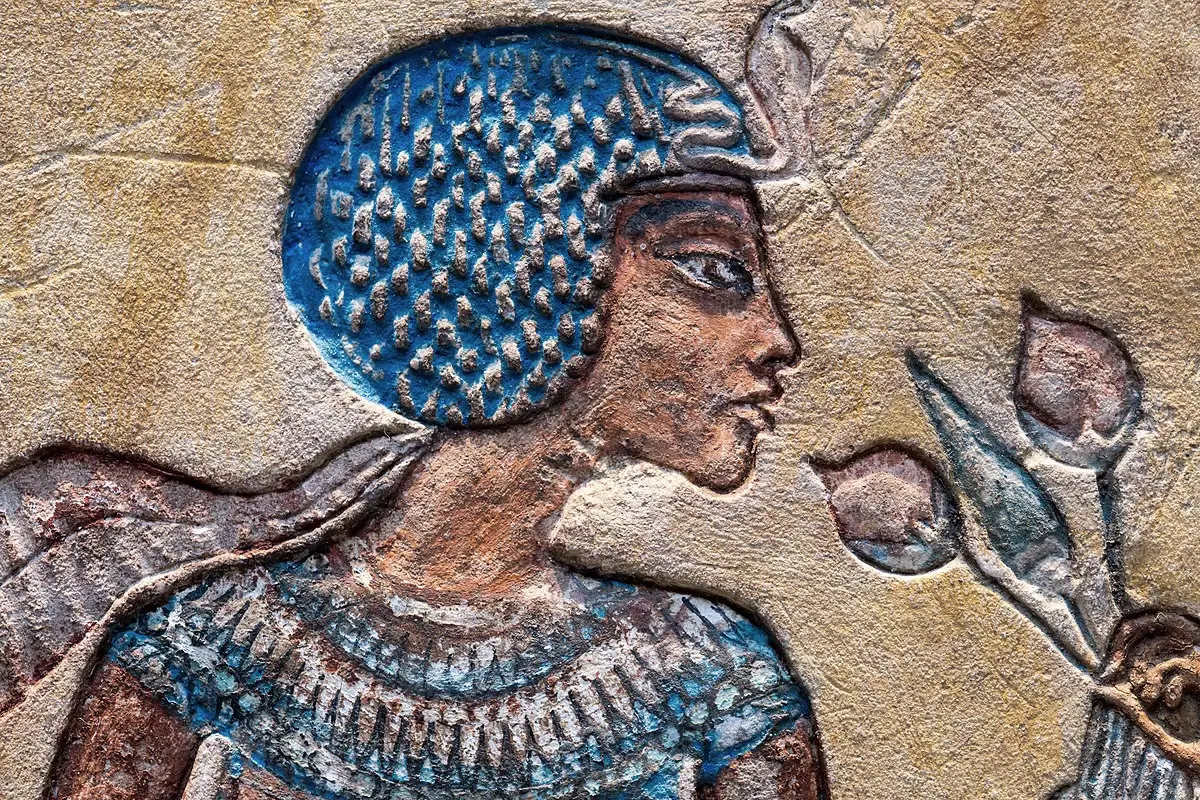
Smenkhkare. Image: Wikimedia Commons
4. The Pharaoh’s Ailments: A Legacy of Inbreeding
Tutankhamun, often envisioned as an emblem of ancient vigor, was actually a pharaoh plagued by health issues. Modern genetics have revealed that his lineage was marked by inbreeding, which likely led to his various maladies, including a clubfoot and malaria. Detailed scans of his mummy have shown deformities in his foot and evidence of necrosis. Such conditions might have hindered his mobility, necessitating the canes found in his tomb.
This insight into his health contradicts the long-held image of a robust young king, painting a more realistic picture of a ruler beset with congenital challenges. The truth behind King Tut’s physical state underscores the potential costs of royal inbreeding practices.

Image: historycollection.com
5. Assassination Theories: The Skull Hole Debate
The discovery of a hole in King Tutankhamun’s skull during initial examinations sparked theories of royal assassination. Early Egyptologists speculated that this damage could be evidence of a fatal blow, suggesting a sinister end for the young pharaoh. However, subsequent forensic investigations have painted a different picture. Detailed CT scans conducted on the mummy revealed that the hole was not a peri-mortem injury but rather an aperture likely created during the embalming process.
Furthermore, genetic analyses have not supported the homicide hypothesis. Instead, they have corroborated the notion that the damage to Tutankhamun’s skull occurred long after his death. Embalmers’ practices included removing the brain, which could account for the cranial opening.
6. The Mystery of the Pharaoh’s Demise: A Chariot Accident?
The circumstances of King Tut’s death at around 18 remain a subject of fascination and debate. Some suggest a chariot accident inflicted the injuries that led to his demise, considering the evidence of his mummy’s fractured leg. These speculations stem from studies of the body’s condition and the royal chariots found in his tomb.
While definitive evidence of such an accident is not established, the theory aligns with known facts about his physical limitations and the risks associated with chariot use at the time. This possible end adds a layer of human vulnerability to the young king’s otherwise divine image.

Image: Wikimedia Commons
7. Not The Only Child Ruler: Tut’s Young Contemporaries
King Tutankhamun is renowned as the boy-king, but he wasn’t an anomaly in the annals of history. Child monarchs were not uncommon in the ancient world, as seen with figures like Ptolemy XIII of Egypt, who was crowned at the age of ten. These youthful ascents often occurred amid political machinations where children served as figureheads for adult regents’ power plays.
The prevalence of such young rulers illustrates the dynastic priorities of the time, where the continuity of lineage often trumped the practicalities of governance. Tut’s story is part of a broader tapestry of child kings who bore the weight of crowns.
8. Erased from History: The Successors’ Attempt
King Tut’s legacy was nearly lost to time, as successors attempted to erase his memory from history. After his death, efforts were made to remove his name and likenesses from monuments—a common practice to discredit pharaohs and reshape historical narratives. Despite these attempts, the chance discovery of his tomb in 1922 brought his story back to life, uncovering the rich details of his reign and burial treasures.
The irony of Tutankhamun’s attempted erasure is that it may have contributed to the preservation of his tomb, as less attention meant fewer chances for grave robbers to plunder it, allowing us to rediscover his legacy.
9. The Twice-Robbed Tomb of the Young King
Before Howard Carter’s discovery, King Tut’s tomb had been violated not once, but twice by ancient grave robbers. The outermost chambers showed signs of hurriedly repacked items, a testament to the thieves’ hasty retreat as they plundered the pharaoh’s riches. Carter’s meticulous records of the tomb’s condition offer a rare glimpse into the aftermath of ancient tomb raiding, reflecting a longstanding human fascination with the treasures of the past.
Despite these breaches, the majority of Tutankhamun’s burial goods remained intact, including his famous gold mask, offering an invaluable snapshot of 18th Dynasty burial practices and the opulence of pharaonic tombs.
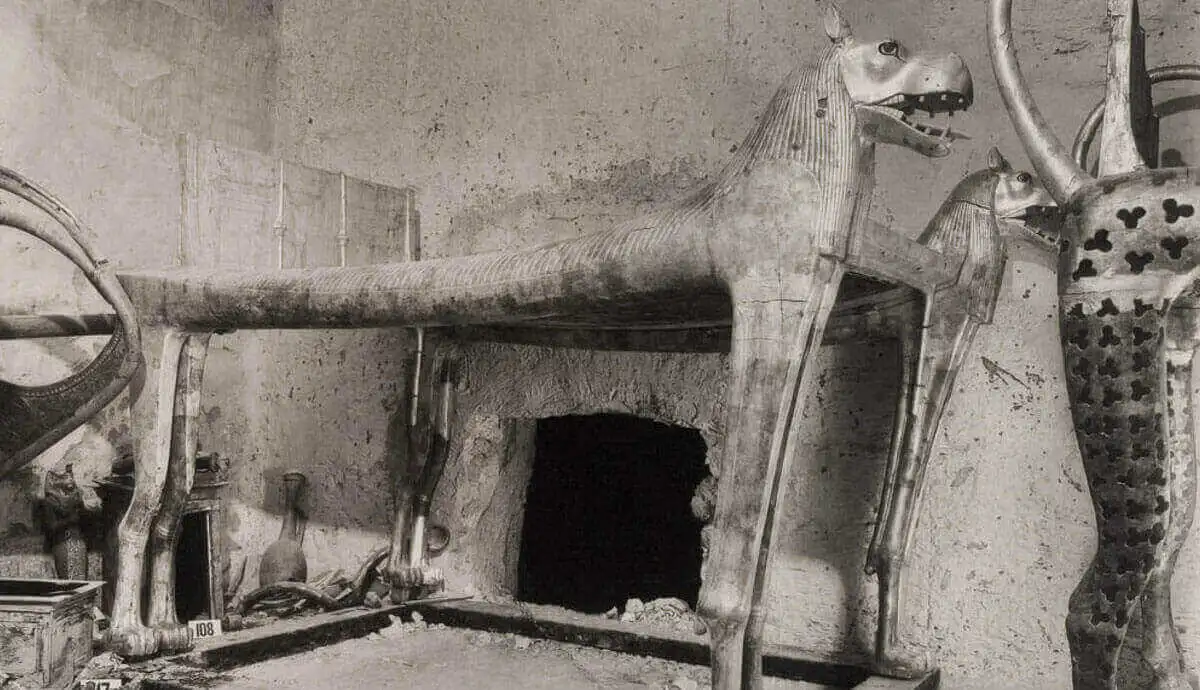
A hole made in the wall of King Tutankhamun’s tomb by robbers soon after his burial. © Copyright Griffith Institute, University of Oxford
10. The Three-Layered Coffin: Gold and Gilded Wood
King Tut’s final resting place was a marvel of ancient craftsmanship, consisting of three nested coffins. The innermost coffin, made of solid gold, cradled the young king’s mummy, showcasing the exquisite artisanship of ancient Egyptian goldsmiths. The outer coffins, adorned with gold leaf and semiprecious stones, protected the inner sarcophagus, illustrating the wealth and status afforded to Egyptian rulers in the afterlife.
This triple-layered protection was not only a symbol of royal prestige but also a measure to ensure the king’s safe passage to the afterlife, reflecting the Egyptians’ complex beliefs about death and rebirth.
11. The Curse of the Pharaoh: Legend or Coincidence?
The curse of Tutankhamun’s tomb is a tale that has endured for a century. After the tomb’s opening, several people associated with the discovery met untimely deaths, fueling rumors of a mummy’s curse. While these stories capture the imagination, they likely reflect human attempts to find patterns in random events.
Scientific examinations have found no evidence of curses, but the legend persists, a testimony to the enduring power of King Tut’s story in popular culture. It’s a phenomenon that intertwines the mysteries of the past with the human psyche’s penchant for myth-making.
12. Space Iron: The Meteorite Dagger
Discovered snug against his thigh, King Tut’s dagger is otherworldly, quite literally. Composed of iron from a meteorite, this blade connects Tutankhamun not just to the heavens but to incredible ancient metallurgy. The dagger’s composition, rich in nickel and cobalt, was a feat of technology that baffles even modern science, considering iron smelting was not common in Egypt at the time of his burial around 1323 BC.
The dagger is a testament to the interconnectedness of ancient cultures and their cosmic beliefs, symbolizing the divine power of pharaohs, who were considered gods among men.
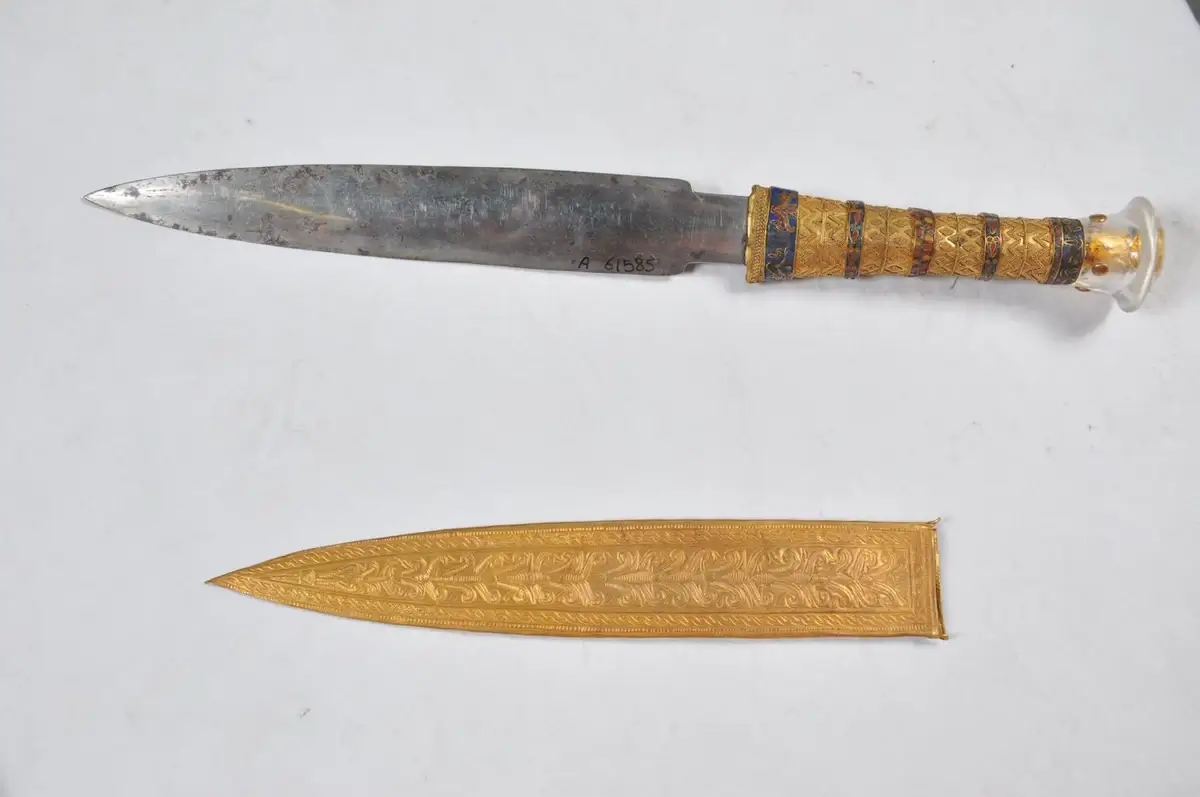
Image: history.com
13. No Hidden Chambers: The Tomb’s Complete Survey
The allure of King Tut’s tomb has long included the tantalizing possibility of hidden chambers, but extensive radar scans have debunked this myth. The non-invasive investigation by a team from the Polytechnic University of Turin in 2017 concluded that there are no concealed rooms adjacent to the tomb. This comprehensive survey put to rest several sensational claims, including one that the tomb of Queen Nefertiti lay undisturbed behind its walls.
The finality of this survey brings a new understanding of King Tut’s burial site, confirming that what was found in 1922 was the complete and final resting place of the young pharaoh.
14. Tutankhamun’s Golden Mask: A Deathly Beauty
King Tut’s golden mask is the epitome of ancient Egyptian artistry and craftsmanship. The visage of the young pharaoh, immortalized in gold, lapis lazuli, and semi-precious stones, has become the symbol of ancient Egypt. Unearthed in 1922, this magnificent artifact masks a morbid truth—it was meant to guide Tutankhamun’s spirit to the afterlife and protect his journey through the underworld.
This mask not only reflects the young king’s status in life but also the elaborate and deeply spiritual burial practices of the time, signifying a journey to eternity that was as opulent as his reign.
Image: worldkings.org
15. The Boy King’s Short Reign: Only a Decade Long
King Tut’s reign was a flicker in the annals of history, lasting just around ten years from 1332 BC to 1323 BC. Yet, in that short span, he witnessed significant religious reforms and left behind treasures that would captivate the world millennia later. His unexpected death, possibly from malaria complications or an infected leg fracture, brought an abrupt end to his lineage and the 18th Dynasty’s rule.
In his brief time as pharaoh, Tutankhamun achieved a level of fame that few other monarchs could match, immortalized by the stunning artifacts that accompanied him to his grave.
16. Military Struggles and International Relations
During Tutankhamun’s reign, Egypt faced military and geopolitical challenges. The army, neglected by Akhenaten, was not the formidable force it had been under Amenhotep III, Tutankhamun’s grandfather.
Tutankhamun’s rule saw unsuccessful military campaigns against the Hittites and the loss of territories like Kadesh. The Hittites grew in power, leading to the fall of Egypt’s ally, the kingdom of Mitanni. These struggles reflect the young pharaoh’s challenges in restoring Egypt’s former glory and stability.
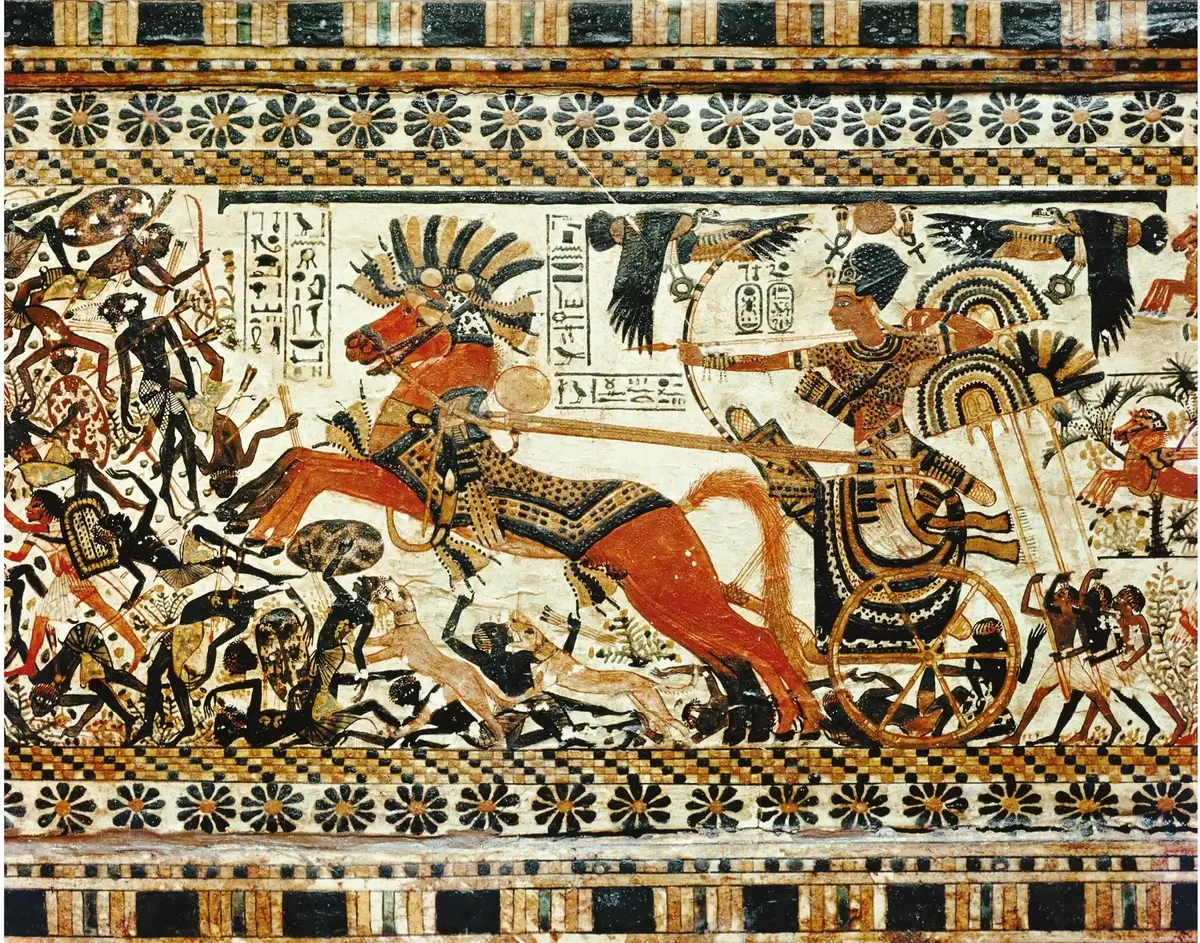
Image: the-past.com
17. The Pharaoh’s Footwear: Fashion for the Disabled
Tutankhamun’s footwear collection reflects the intersection of disability and royal dignity. Among his possessions were over 130 walking sticks, signifying his need due to his clubbed foot, and intricately designed sandals that accounted for his physical challenges. These weren’t merely practical; they were symbols of status, embellished with gold and precious stones.
This convergence of necessity and luxury illustrates ancient Egypt’s approach to disability and nobility, crafting items that served both function and fashion for their divine ruler.
18. Ceremonial Artifacts as Childhood Toys
Tutankhaten, as he was known in his early life, came to the throne around 1336 BCE when he was about eight or nine years old. Found in his tomb were miniature symbols of royalty, like the crook and flail, which he likely played with as a child while being groomed for future rule.
These items, inscribed with his birth name, suggest that he was crowned as Tutankhaten, demonstrating his early preparation for kingship.
19. Ankhesenamun: The Lost Queen
Ankhesenamun, King Tut’s widow, vanishes from history after her husband’s death. Her life is a tapestry of ancient Egypt’s politics, as she was married first to her father, Akhenaten, and then to her half-brother Tutankhamun. After Tut’s death, her fate is a mystery, with suggestions of a possible marriage to her grandfather Ay or a foreign prince.
Her story is as much a part of Tutankhamun’s narrative as the treasures in his tomb, a reminder of the human element behind the golden masks and hieroglyphs.
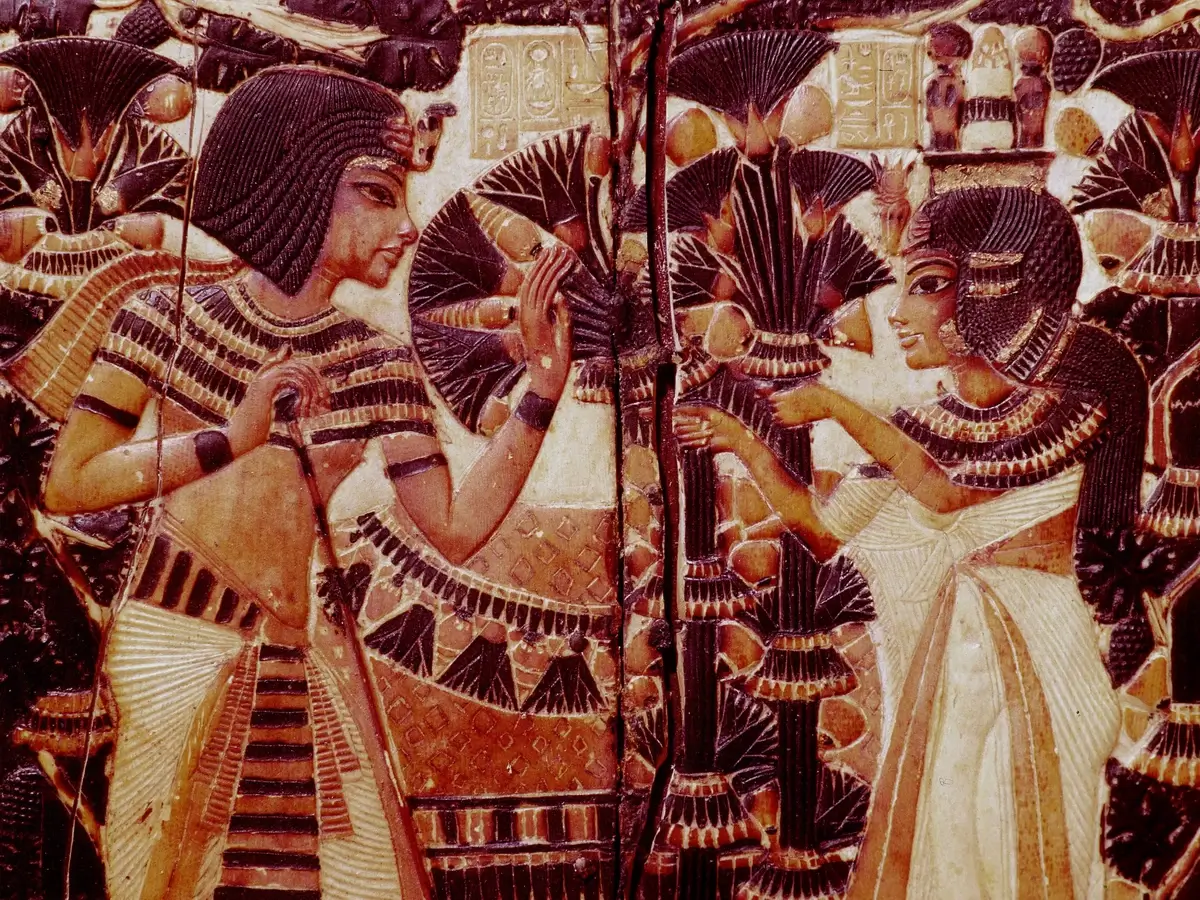
Tutankhamun and Queen Ankhesenamun. Image: bklyntimes.com
20. The Lotus Chalice: Symbol of Eternal Life
The Lotus Chalice found in Tutankhamun’s tomb is a masterpiece symbolizing rebirth and eternal life. Crafted from a single piece of alabaster, its sides are engraved with delicate lotus blossoms and buds, representing the sun and creation. This chalice wasn’t just a vessel; it was an emblem of the pharaoh’s journey to the afterlife, encapsulating the Egyptian belief in life after death.
The beauty and intricacy of the Lotus Chalice are remarkable, reflecting the artistry of the time and the spiritual significance of the lotus in ancient Egyptian culture.
21. Early Royal Duties and Artistic Patronage
As a child pharaoh, Tutankhamun was surrounded by symbols of royalty and was involved in the duties of kingship from a very young age.
Historical records suggest that he was active in commissioning art and participating in religious ceremonies. For instance, he is credited with commissioning work on the colonnade in the Luxor Temple, which is adorned with scenes of the Opet Festival, highlighting his role as a patron of the arts and religious life.
22. The Royal Palace and Living Conditions
King Tutankhamun and his queen, Ankhsenamun, resided in a royal palace that was built of mud brick and was lavishly decorated with vibrant frescoes depicting various scenes, including those of nature and daily life.
The palace was designed with multiple large rooms and columned halls, leading to an impressive throne room. Gardens and pools within the palace grounds were intended to offer a serene and pleasing environment for the royal couple.
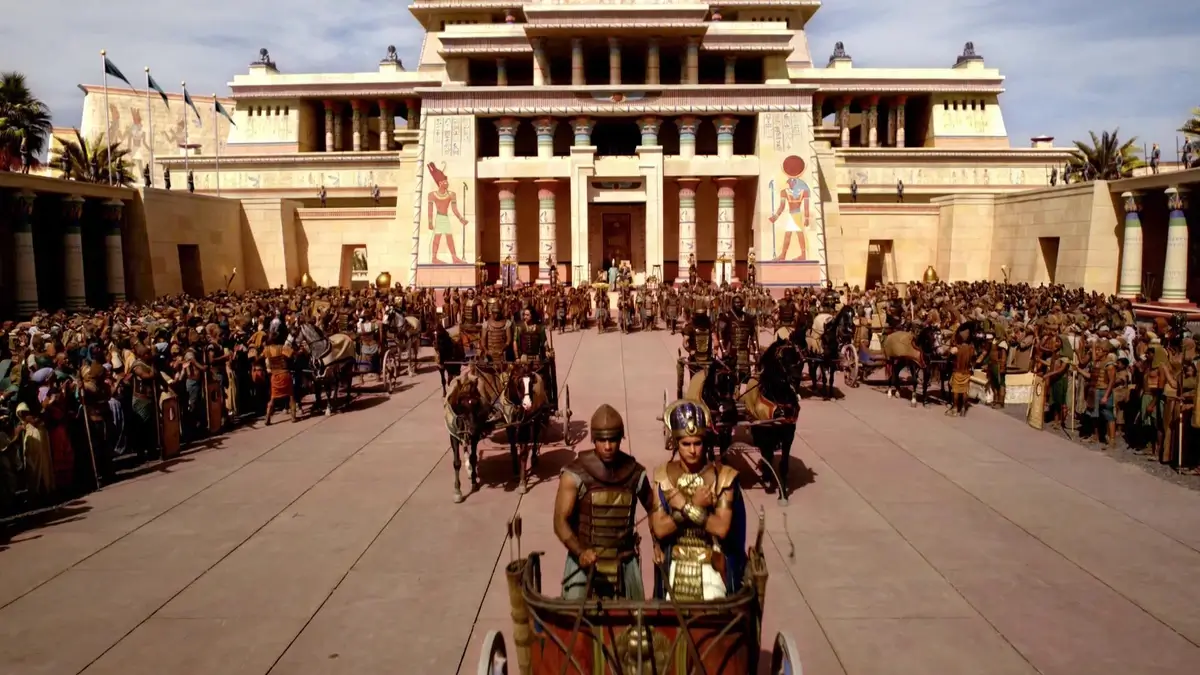
Image: fandom.com
23. The Boy King’s Wives: A Tale of Two Sisters
Tutankhamun’s marital life is a narrative of royal duty and alliance. He married his half-sister Ankhesenamun, and possibly a second wife, his sister Ankhesenpaaten Tasherit. These unions were customary in royal circles, aimed at preserving the divine bloodline. The pharaoh’s wives played significant roles in religious and state affairs, evident from the artifacts depicting them in the tomb.
Their stories provide insight into the complex familial and political webs of the time, showcasing the intricate roles women played in the narrative of the pharaohs.
24. Youthful Rule and Potential for Greatness
Tutankhamun’s reign, although short, was marked by significant efforts to address the issues left by his father’s rule. Advised by senior officials such as Ay and Horemheb, the young king endeavored to restore Egypt’s stability and prosperity.
There is a sense among historians that, had he lived longer, Tutankhamun might have achieved even more for Egypt, suggesting his potential to be remembered not just for his tomb’s treasures but for his leadership as well.
25. The Legacy Lives: King Tut’s Pop Culture Influence
King Tut’s discovery fueled a global phenomenon, influencing fashion, film, music, and literature. The “boy king” has become a symbol of ancient Egypt, his golden mask an icon recognized around the world. This fascination has led to numerous cultural references, from Andy Warhol’s pop art to blockbuster exhibitions that draw millions.
Tutankhamun’s story resonates beyond academia, embodying the allure of ancient mysteries and the splendor of discovery. His legacy in pop culture is a testament to the timeless intrigue surrounding his life and the world he inhabited.
FAQ
What famous things did King Tut do?
King Tutankhamun is famous for his role in restoring the traditional polytheistic religion of ancient Egypt. He reigned from around 1332 to 1323 BCE and reversed the radical monotheistic reforms of his predecessor and possible father, Akhenaten. Tutankhamun reinstated the worship of Amun and other deities and returned the religious capital to Thebes from Akhenaten’s construct, Amarna.
How did King Tut die at 19?
The cause of King Tutankhamun’s death has been the subject of much speculation and debate. Theories have ranged from murder to various health issues. Recent scientific analyses, including CT scans, suggest that he may have died from complications related to malaria and a leg fracture, rather than assassination as was once suspected.
How tall was King Tut when he died?
Studies of King Tutankhamun’s mummy indicate that he was about 167 centimeters (5 feet 6 inches) tall when he died.
How many people died because of King Tut?
There is no historical evidence to suggest that people died because of King Tutankhamun. The myth of the “curse of the pharaohs,” implying that those who entered his tomb faced death, is not supported by factual evidence. Many of the tomb’s discoverers and associated personnel lived long lives after the event.
What was King Tut’s favorite food?
The specific favorite food of King Tutankhamun is not known. However, the diet of Egyptian pharaohs typically included bread, fruit, vegetables, and meat, with wine and beer as common beverages.
Why is King Tut a hero?
King Tutankhamun is often considered a hero in modern times more because of the fascination with his tomb and its treasures than for specific heroic acts. The wealth of artifacts found in his tomb has provided invaluable insights into ancient Egyptian culture and history.
How old was King Tut as King?
King Tutankhamun became king at approximately 8 or 9 years of age and ruled until his death at around 19 years old, making his reign approximately 10 years long.
What was King Tut’s real name?
King Tutankhamun’s original name was Tutankhaten, which means “Living Image of Aten.” After his ascension to the throne, his name was changed to Tutankhamun, meaning “Living Image of Amun,” reflecting the religious shift back to the worship of Amun.
Who did King Tut marry?
King Tutankhamun married his half-sister Ankhesenamun, who was originally named Ankhesenpaaten. She was the third daughter of Akhenaten and Nefertiti.
What was King Tut buried with?
King Tutankhamun was buried with a vast array of goods intended for his use in the afterlife. This included chariots, thrones, clothing, weapons, food, wine, and a remarkable collection of jewelry. His tomb also contained the iconic gold funerary mask that has become synonymous with his name.


